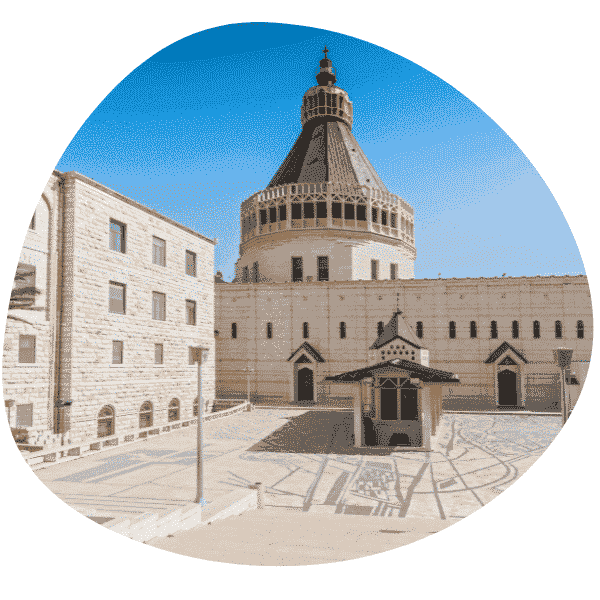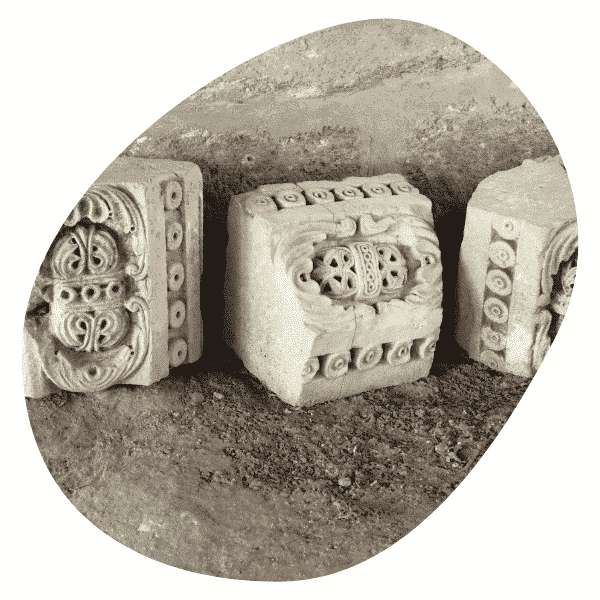LET'S PRESERVE NAZARETH TOGETHER
The place where the History of Salvation began
In this period where conflicts and sufferings tear the whole world apart, we are called to keep our gaze fixed on the place where the History of Salvation began and where our hope originates: the humble house of Nazareth where Mary received the announcement of the Angel.
There, in the exact place where the Word became flesh, from the first centuries Christians have guarded and venerated the small cave that was the house of Mary, around which today stands the Basilica of the Annunciation.

NAZARETH
The Basilica of the Annunciation
Like many shrines in the Holy Land, the Basilica of Nazareth also has a fascinating history behind it, which it is important to make understandable to pilgrims from all over the world.
For this reason, the Franciscans for 800 years custodians of the sanctuaries of the Holy Land, continue the study of the finds and testimonies that allow us to reconstruct the history of the Holy Places.
To support the Franciscan work, however, we really need the help of all Christians who, today as in past centuries, care about the place where our faith originates.
IN NAZARETH
These are not just stones...
Knowing the history of the shrine of Nazareth allows us to grasp the traces of the facts narrated in the Gospels and to understand that we are part of a community of believers who for 2,000 years have lived the mystery of the Incarnation of Christ.
The oldest trace of Marian worship in Nazareth, in fact, is prior to the middle of the fifth century: an engraving in Greek, left by ancient pilgrims on the basis of a column and discovered only a few years ago. The inscription clearly shows the name of Μαρία "Mary" preceded by an abbreviation of two letters Χε, interpreted as Χαίρε "Chaire", corresponding to the Latin "Ave".
It is the angelic greeting addressed to the Virgin, according to the Gospel of Luke: "Hail Mary".
The inscription confirms with certainty that even then the small cave of Nazareth was venerated as the place of the announcement of the Angel.
These discoveries are important because they make us understand how Marian devotion has always been fundamental for Christians.
The inscription in question predates even the Council of Ephesus, which represents the official beginning of the worship of Mary Mother of God.
IN NAZARETH
The walls tell stories...
During the Crusader era, a large basilica was built in Nazareth. The perimeter walls of this ancient sanctuary were rediscovered during the excavations for the construction of the current Basilica, along with many finds of extraordinary importance, but still awaiting restoration.
Among them are the remains of the large decorative arch of the west portal.

HELP US PRESERVE
The traces of our faith
The remains of the arch are now in the warehouses of the Custody of the Holy Land, but our desire is to restore them to exhibit and explain them to pilgrims. All these historical testimonies, in fact, are important because they show how from the beginning Christians all over the world went on pilgrimage to the Holy Land and loved and guarded the traces of the life of Jesus among men in churches and shrines.
NAZARETH
The history of the place of the Annunciation
In the place that tradition identifies as the cave where the House of Mary stood, today stands a huge basilica, the Basilica of the Annunciation, which was built in the second half of the Twentieth Century.
But what was there before then?
NAZARETH IN ROMAN TIMES
Can something good come from Nazareth?
Although Nazareth was located on the famous Via Maris, the trade route along the coast from North to South, the evangelical testimonies seem to indicate that the country maintained a humble conformation, unlike the nearby Sepphoris which instead was very flourishing.
This is also confirmed by the archaeological finds of the ancient village. During the excavations, numerous ancient houses were found, which were carved into the rock or exploited the caves. So also the house where the Angel appeared to Mary.
THE BYZANTINE BASILICA
The very first testimonies
In Byzantine times there were Christian buildings of worship in the city, including a church on the remains of which the later basilicas will rise. Even today, in front of the Grotto of the Annunciation, the structure of the Byzantine basilica with the apse facing east can be recognized. The finds show that beneath this must have been an even older Christian temple. In addition, various historians such as Hegesippus and Eusebius of Caesarea, close to proto-Christian circles, report the pride that some made in Nazareth, that they belonged to the family of Jesus.
The anonymous pilgrim of Piacenza, in the middle of the sixth century, still speaks of this proximity to the House of the Lord. In his diaries he claims to have found in the city wonderful women, who indicate as the cause of their beauty their own blood closeness to the Virgin Mary.
THE CRUSADER BASILICA
The great crusader basilica
The Crusaders built a huge basilica in Axis with the Byzantine one. The basilica measured 70 meters in length and 30 in width. The remains are still visible today in the walls of the current basilica. In 1263, however, the church was destroyed by Sultan Bibars and never rebuilt for a long time.
Traces of the Christian Nazareth are lost until the seventeenth century, when the Franciscan friars managed, between alternating events, to regain possession of the ruins of the destroyed church. Thus began a process of daily coexistence between the faiths that again led to the reestablishment of peace in the city. The same peace of which the life of the future Saint Charles de Foucauld bears witness, who Here lived part of his vocation to the Consecrated Life.
THE BASILICA TODAY
The new Basilica
In 1620 when the Franciscans took possession of the ruins of the Crusader basilica and the cave and with alternate vicissitudes they were a presence in Nazareth and in 1730 they obtained the opportunity to build a church on the cave.
The current basilica instead is consecrated in 1969 was built by tearing down the Church of 1730 and grafting on the remains of the Crusader basilica and the mosaics of the Constantinian era…the works of Nazareth were an exceptional opportunity for study and in the excavations it was understood that below there were traces of a pre-existing synagogal building…
The synagogue where Jesus went? And where was he surprised by wisdom, who was the son of Joseph?
NAZARETH
The history of the place of the Annunciation
In the place that tradition identifies as the cave where the House of Mary stood, today stands a huge basilica, the Basilica of the Annunciation, which was built in the second half of the Twentieth Century.
But what was there before then?
NAZARETH IN ROMAN TIMES
Can something good come from Nazareth?
Although Nazareth was located on the famous Via Maris, the trade route along the coast from North to South, the evangelical testimonies seem to indicate that the country maintained a humble conformation, unlike the nearby Sepphoris which instead was very flourishing.
This is also confirmed by the archaeological finds of the ancient village. During the excavations, numerous ancient houses were found, which were carved into the rock or exploited the caves. So also the house where the Angel appeared to Mary.
THE BYZANTINE BASILICA
The very first testimonies
In Byzantine times there were Christian buildings of worship in the city, including a church on the remains of which the later basilicas will rise. Even today, in front of the Grotto of the Annunciation, the structure of the Byzantine basilica with the apse facing east can be recognized.
The finds show that beneath this must have been an even older Christian temple. In addition, various historians such as Hegesippus and Eusebius of Caesarea, close to proto-Christian circles, report the pride that some made in Nazareth, that they belonged to the family of Jesus.
The anonymous pilgrim of Piacenza, in the middle of the sixth century, still speaks of this proximity to the House of the Lord. In his diaries he claims to have found in the city wonderful women, who indicate as the cause of their beauty their own blood closeness to the Virgin Mary.
THE CRUSADER BASILICA
The great crusader basilica
The Crusaders built a huge basilica in Axis with the Byzantine one. The basilica measured 70 meters in length and 30 in width. The remains are still visible today in the walls of the current basilica. In 1263, however, the church was destroyed by Sultan Bibars and never rebuilt for a long time.
Traces of the Christian Nazareth are lost until the seventeenth century, when the Franciscan friars managed, between alternating events, to regain possession of the ruins of the destroyed church. Thus began a process of daily coexistence between the faiths that again led to the reestablishment of peace in the city. The same peace of which the life of the future Saint Charles de Foucauld bears witness, who Here lived part of his vocation to the Consecrated Life.
THE BASILICA TODAY
The new Basilica
In 1620 when the Franciscans took possession of the ruins of the Crusader basilica and the cave and with alternate vicissitudes they were a presence in Nazareth and in 1730 they obtained the opportunity to build a church on the cave.
The current basilica instead is consecrated in 1969 was built by tearing down the Church of 1730 and grafting on the remains of the Crusader basilica and the mosaics of the Constantinian era…the works of Nazareth were an exceptional opportunity for study and in the excavations it was understood that below there were traces of a pre-existing synagogal building…
The synagogue where Jesus went? And where was he surprised by wisdom, who was the son of Joseph?



















